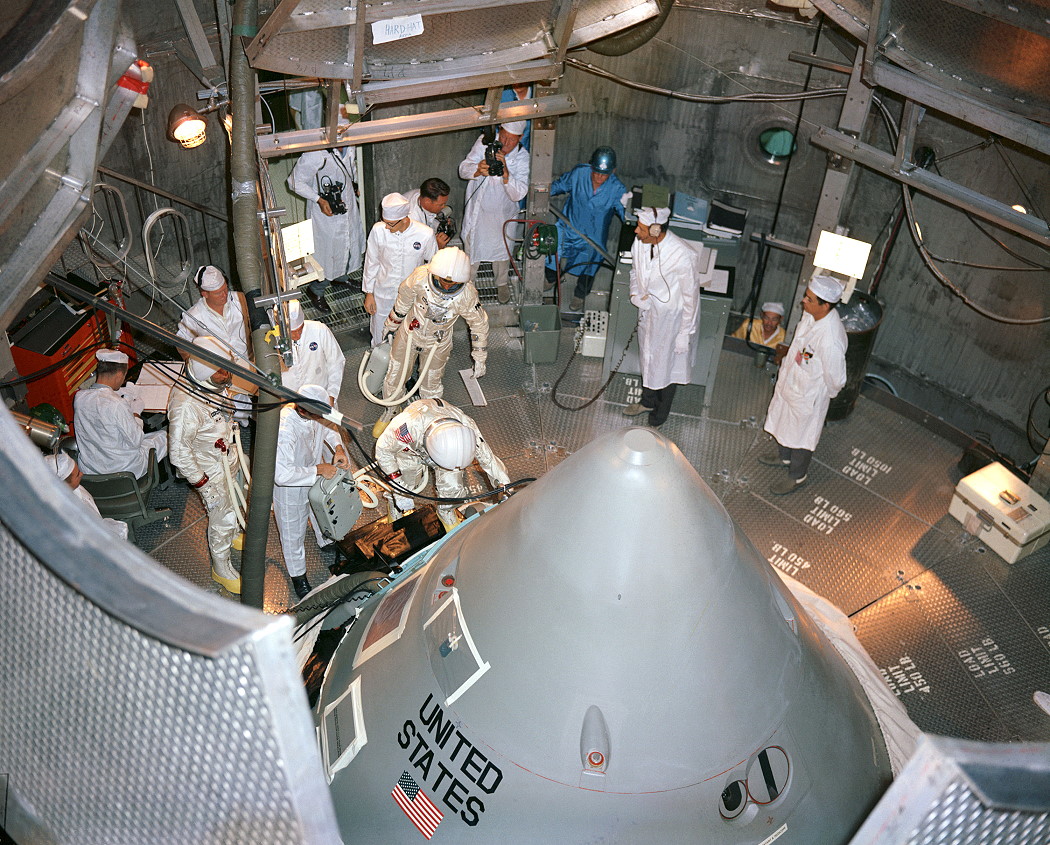
Figuratively and literally, February is a gloomy month, particularly in the Northern Hemisphere—a four-week period of darkness, plunging temperatures, and poor weather, with the joy of Christmas a distant memory and the first stirrings of spring still a long way off. On three occasions in NASA’s history, the metaphorical darkness has been at its most acute at this time of year which by cruel misfortune has seen the losses of the Apollo 1 crew in a pad fire in 1967, followed by the Challenger crew in a launch catastrophe in 1986 and more recently the Columbia crew in a failed re-entry in 2003, all within a span of just a few days on the January/February cusp. In this weekend’s series of history articles, AmericaSpace will reflect not upon the disasters themselves—each of which has been widely covered elsewhere—but upon the year of human space exploration which was lost in each calamity and what might have been accomplished in 1967, 1986, and 2003.
For NASA, 1967 was expected to be a banner year. Project Gemini had ended on a triumphant high the previous November, having demonstrated the critical capabilities of rendezvous, docking, maneuvering, spacewalking, and long-duration spaceflight, all of which would be needed to accomplish the late President John F. Kennedy’s goal of American bootprints on the Moon before the end of the decade. The original line-up for Project Apollo envisaged a seven-step process, labeled “A” through “G,” putting the new spacecraft through low- and high-Earth-orbital test flights of its command, service, and lunar modules, before advancing to lunar distance and ultimately accomplishing one of humanity’s most exalted and long-sought-after goals: a piloted landing on the Moon.
However, as described in AmericaSpace’s Apollo 1 memorial article last week, there remained many technical hurdles before such a goal could be entertained. NASA’s planning called for as many as three Apollo missions in 1967, of which Apollo 1—crewed by Commander Virgil “Gus” Grissom, Senior Pilot Ed White, and Pilot Roger Chaffee—would have undertaken an initial manned shakedown of the “Block 1” version of the spacecraft, capable only of missions into low-Earth orbit, in February-March. Original plans called for a virtually identical flight of the Block 1 vehicle (Apollo 2), whose crew was named in September 1966: Commander Wally Schirra, Senior Pilot Donn Eisele, and Pilot Walt Cunningham. Apollo 2 would have flown for up to 14 days, approximately the same as its predecessor, and would also have featured tests of the Service Propulsion System (SPS) engine of its service module, but Schirra’s disinterest in its lack of challenge prompted him to argue that it “made no sense to do a repeat performance.” In November 1966, Apollo 2 was cancelled and, much to Schirra’s annoyance, his crew was not assigned to a new mission, but named instead as the backups for Grissom, White, and Chaffee.
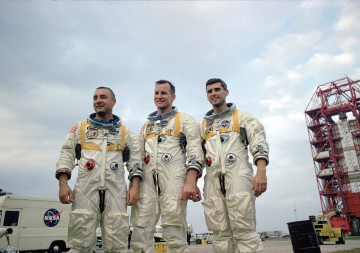
Under the revised plan,”new” Apollo 2 would involve a test flight of the command, service, and lunar modules in low-Earth orbit, after which Apollo 3 would attempt a similar feat in a high Earth orbit. In December 1966, the crews for the two missions were announced. Apollo 2 would comprise Commander Jim McDivitt, Command Module Pilot Dave Scott, and Pilot Rusty Schweickart, whilst Apollo 3 consisted of Commander Frank Borman, Command Module Pilot Mike Collins, and Lunar Module Pilot Bill Anders. Both crews would have utilized a more sophisticated “Block 2” spacecraft, which possessed the navigational, rendezvous, and docking capabilities necessary for high-Earth-orbital and lunar expeditions. “There were hundreds of differences between the two,” wrote Deke Slayton, then-head of the Flight Crew Operations Directorate (FCOD), in his autobiography, Deke, “the major one being that Block 1 vehicles didn’t have the docking tunnel that would allow you to dock with a lunar module.”
Had fire and the effects of brutal asphyxia not snatched the lives of Grissom, White, and Chaffee on the evening of 27 January 1967, the three men were expected to launch—according to Flight Director Chris Kraft at the Apollo News Media Symposium, held in mid-December of the previous year—in late February or early March. They were tasked with an “open-ended” flight in low-Earth orbit, lasting anywhere from six orbits to 14 days. In his book on lost and forgotten Apollo missions, spaceflight historian Dave Shayler wrote that it was certainly the intention of Grissom’s crew to fly for as long as was practical, in order to extract as much valuable engineering data from the spacecraft as possible.
However, Shayler acquiesced that the Block 1 vehicle was almost certainly incapable of supporting missions of longer than 14 days. Today, of course, it remains a moot point to consider what flight duration Apollo 1 might have achieved, but it seems unlikely that it would have seriously threatened the 14-day empirical record established by Gemini VII astronauts Borman and Jim Lovell in December 1965. Indeed, in the weeks before he lost his life aboard Apollo 1, Grissom joked darkly that as long as his crew returned from orbit alive, he would consider the mission a success. His fatalistic outlook and lack of confidence in Block 1—whose hundreds of unresolved technical problems included a faulty glycol pump in the environmental control system, leaky thrusters, coolant glitches, bad wiring, and inadequate software—was shared by many of his fellows within the Astronaut Office.
Apollo 1’s launch date was refined, by the eve of the fire, to around 21 February 1967. Internally, the mission was known as “Apollo-Saturn 204” (AS-204) and would have made Grissom, White, and Chaffee the first humans to ride Wernher von Braun’s mighty Saturn IB booster, a two-stage behemoth which, in just 11.5 minutes, would have delivered their 44,980-pound (20,400-kg) spacecraft into an orbit of 85 x 130 miles (140 x 210 km). The clumsy “AS-204” nomenclature described the launch vehicle as the fourth production unit of the Saturn IB, but the crew had successfully pushed to rename their flight “Apollo 1.”
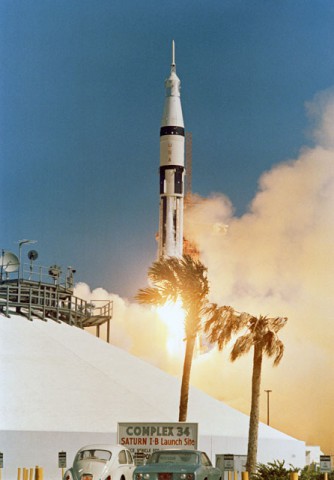
Minutes after achieving orbit, White would have unstrapped and headed into the command module’s lower equipment bay to set up cameras and scientific hardware. Two and a half hours into the flight, he and Chaffee would have returned to their seats as Grissom uncoupled Apollo 1 from the S-IVB final stage of the booster. Under his control, the spacecraft would have maintained a tight formation with the spent stage as White and Chaffee photographed the venting of its residual propellants. Much of this work was critical for future missions to the Moon, for the lunar module aboard the larger Saturn V would utilize the upper portion of the S-IVB as a temporary “garage” during ascent and physically extracted by the command and service module.
No rendezvous maneuver was planned during Apollo 1, but several tests of the large Service Propulsion System (SPS) engine on the service module were intended. In total, it would have been fired eight times—three times by Grissom and White and twice by Chaffee—with the astronaut responsible for “flying” each burn stationed in the left-side commander’s seat. The first pair of SPS firings would have occurred during Apollo 1’s second day in orbit, with the others executed at roughly 50-hour intervals throughout the remainder of the mission.
Additionally, the crew was assigned one of the largest complements of scientific, photographic, and medical experiments ever carried into orbit. During their flight, they would have monitored aerosol concentrations in the command module’s cabin, carried out synoptic terrain photography of diverse targets ranging from the coast of Africa to the Mississippi River Mouth and Oyster Bay in Jamaica to the South China Sea, and observed a range of meteorological and marine phenomena, from cloud eddies to dust storms and smog-laden cities to ocean currents. Other photographic tasks and medical investigations—an in-flight exerciser, a photocardiogram to monitor heart function, and an otolith “helmet” to track the effects of microgravity on the balance mechanism of the inner ear—would have filled much of their time. Moreover, they would have been required to evaluate every aspect of the spacecraft itself, from its rudimentary “toilet” to its general habitability.
Had their mission gone ahead and run to its maximum length, the three men would have returned to Earth on 7 March, separating from their service module a few minutes before plunging into the upper atmosphere. The command module would then have borne the brunt of re-entry heating and finally, beneath a canopy of three red-and-white parachutes, would have splashed into the Pacific Ocean, some 330 hours after launch. Assuming nothing untoward happened, the flight of Apollo 1 would clear the way for the first mission of the Block 2 spacecraft and, eventually, for a lunar landing, possibly as soon as late 1968.
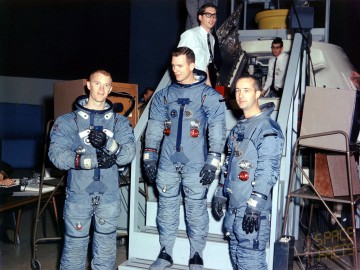
Thanks to Apollo 1 backup commander Wally Schirra, there would only be one manned Block 1 flight. Originally, NASA wanted to virtually duplicate Grissom’s mission with Apollo 2, featuring Schirra, Donn Eisele, and Walt Cunningham. However, the man who had commanded the world’s first space rendezvous in December 1965 wanted nothing to do with it. “I argued it made no sense to do a repeat performance,” he wrote in his memoir, Schirra’s Space, “and I succeeded in getting the mission scrubbed.” (In fact, Walt Cunningham, in a 1999 oral history for NASA, speculated that Deke Slayton himself hoped to command Apollo 2, but was overruled. Slayton made no reference to this in his own autobiography.) Regardless of Schirra’s involvement, the hands of fate had already turned on Apollo 2 by October 1966, when the propellant tanks inside one of the service modules exploded during a ground test. Although it had not been assigned to Apollo 2, it made sense to keep downstream flights on schedule, replace it with Schirra’s service module, and cancel the “repeat performance.” Whether he liked it or not, Schirra was told on 15 November that Apollo 2 was no more.
In winning his battle to get rid of the second Block 1 mission, Schirra had shot himself in the foot because he, Eisele, and Cunningham were reassigned in early December as Grissom’s new backup team. Schirra was reluctant to accept the change—he wanted a mission of his own that would provide a challenge and certainly did not want to serve on another backup crew—but Slayton and Grissom eventually talked him around. (He would complain to Tom Stafford, however, that Slayton had “screwed him.”) Meanwhile, astronauts Jim McDivitt, Dave Scott, and Rusty Schweickart, who had served as Apollo 1’s backups since March 1966, would now become the prime crew of a “new” Apollo 2, which would test the lunar module in Earth orbit on a mission involving two Saturn 1Bs. The three men would be launched atop the AS-205 Saturn IB, after which their lunar module would be launched unmanned about 24 hours later, atop the AS-208 Saturn IB. McDivitt had been working on the lunar module for more than a year and Scott had rendezvous experience, so it made sense to assign them, rather than Schirra’s team, to this mission. In the aftermath of the fire, their mission wound up as Apollo 9.
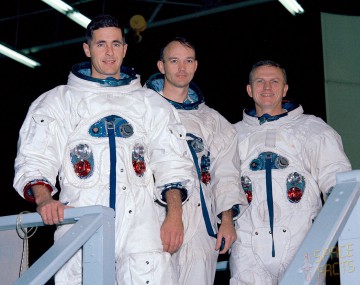
Next up would be Frank Borman, Mike Collins, and Bill Anders on Apollo 3, tasked with the first manned flight of the Saturn V to a highly elliptical Earth orbit, reaching an record-breaking apogee of more than 4,000 miles (6,400 km). According to Collins in his autobiography, Carrying the Fire, the S-IVB “would be reignited, just as if it were a lunar mission … However, ours would be shut down early, causing us to stay in Earth orbit.” He added that “this little detail created all sorts of planning problems, because one could only escape from this lopsided orbit at certain prescribed intervals and if one had troubles and was forced to return to Earth prematurely, it was entirely possible to end up landing in Red China.” In a sense, the altitude achieved would not have been dissimilar to that accomplished by the Exploration Flight Test (EFT)-1 mission of NASA’s Orion spacecraft in December 2014.
Had the Apollo 1 fire not occurred, the Apollo 2 and 3 missions might have taken place as soon August and December 1967, thereby passing several fundamental hurdles in demonstrating the spacecraft’s myriad components and capabilities and setting the stage for a lunar landing a year or so later. As circumstances transpired, the Apollo 3 mission profile was never used for a piloted flight and, by the late summer of 1968, NASA was already looking at advancing its outward trajectory to lunar distance in a key step toward achieving President Kennedy’s pledge of a man on the Moon before the end of the decade.
The second part of this article will appear tomorrow and will focus on the year which might have followed the final flight of Challenger in 1986.
Want to keep up-to-date with all things space? Be sure to “Like” AmericaSpace on Facebook and follow us on Twitter: @AmericaSpace




For a look at such a world, take a look at my short story Mirrored Lives.